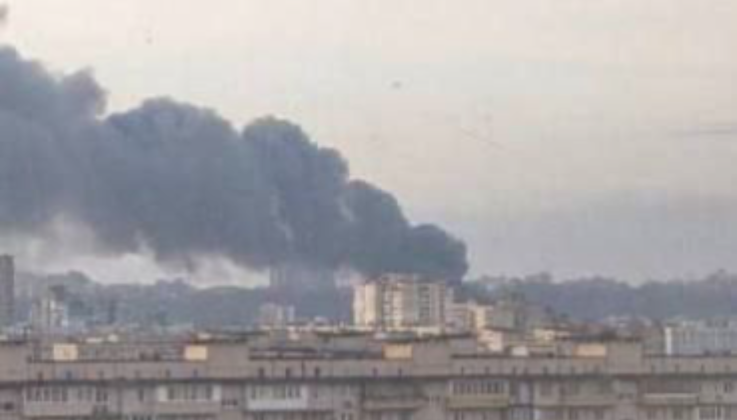
Image allegedly showing burning military warehouse in Kiev.
Following major advances on the frontlines in Eastern Ukraine by Russian Army units, including the capture of the strategically located town of Maryinka which was at the centre of Ukrainian forces' presence in the Donetsk region, the Russian Armed Forces on December 29 launched their largest ever series of missile strikes on Ukrainian positions. Before 7am local time Ukrainian monitoring resources had reported that 18 Russian strategic bombers had taken off, with nine Tu-95MS and nine Tu-22M3 bombers prepared to launch cruise missiles against targets in Ukraine.
The close monitoring of Russian airbases hosting such assets had long been used to provide some warning of impending strikes, although the ability of bombers to loiter in the air for hours, and from October the
constant patrols by ballistic missile armed MiG-31K strike fighters, had made this significantly more difficult.
Eighteen of Russia's intercontinental range Tu-95MS bombers would reportedly participate in strikes over the course of the day according to Ukrainian sources, with Ukrainian officers highlighting that the Kh-22 missiles launched by Tu-22M3 bombers in particular had proven effectively impossible to shoot down with not a single one intercepted since the war began.
Russian Geran-3 drones, a new single use design developed with Iranian support, had launched initial strikes on Ukrainian positions around midnight, reaching even the Lviv region in the far west of the country, while also concentrating attacks on the southern Odessa region. Other targets for the drones included airfields in Kiev and a range of targets in the Vinnitsa regions. Subsequently in the morning a range of air and sea launched missiles struck targets across Kharkov, Dnepropetrovsk, Kiev, Zaporozhye and Odessa, as well as an airfield in Mirgorod and further targets in the Cherkasy and Vinnytsia regions. Missiles used included the Navy's Kalibr, the air launched Kh-59 and Kh-22 cruise missiles, the
Kh-47M2 air launched ballistic missile, and the 9K720 ballistic missile from the Iskander-M system, making it by far the largest strike of the war.
Attacks on further targets continued into the afternoon, with Ukrainian air defence personnel reportedly exclaiming regarding the missiles: "We have never seen so many targets on our monitor at the same time." Additional missiles later reported to have been used included the Kh-32 launched by Tu-22M3 bombers, bomber launched Kh-101 missiles, and even surface to air missiles from Soviet built S-300 systems which were repurposed as surface to surface assets.Regarding the nature of the targets engaged, Russian sources reported that a base of
Western military contractors was struck in Lviv, as were energy facilities and warehouses. In Khmelnitsky an airfield, aircraft, and various warehouses were attacked, while in Kharkov an airfield, warehouses and energy infrastructure were struck, and in Dnepropetrovsk an additional airfield was targeted. In the capital Kiev, by contrast, the primary targets were factories and the
city's energy infrastructure. In Odessa missiles targeted terminals, warehouses and ports, in Nikolaev an airfield, port, fuel terminals and control headquarters, and in Kherson, Kanatop and Zaporozhye warehouses and air defence equipment including missile sites. Located nearer the frontlines, Kherson also saw personnel concentrations targeted. European Storm Shadow/SCALP long range cruise missile warehouses and airfields hosting their launching aircraft were reportedly particularly prioritised.
The strikes thus engaged a range of both strategic and tactical targets across Ukraine, with over 100 missiles and several hundred single use drones launched over an 18 hour period.The escalated Russian strikes on targets across Ukraine follow a
surge in missile production at facilities across Russia to several times pre-war levels, which has allowed the country to
significantly increase the intensity of strikes both on frontline positions and on targets in major cities hundreds of kilometres away. A notable example was the 9K720 ballistic missile used by the the Iskander-M, much greater availability of which has for weeks allowed Russian forces to launch 'double strikes' on Ukrainian frontline positions to maximise casualties.
Increasingly severe munitions shortages in the Ukrainian Army, by contrast, have seriously limited the fighting capacity of frontline units - with this reported in Western interviews with personnel in deployments ranging from elite mechanised brigades to artillery forces. Ukrainian air defences, too, were already thinly stretched by the autumn of 2022, with massive Soviet era arsenals of S-300 and BuK systems increasingly worn thin while the age of the assets has also posed issues.
In the latest attack a Ukrainian surface to air missile was seen striking a residential building in one such mishap. Growing indications that Ukrainian forces are close to
breaking point, and that Kiev's Western backers are looking to negotiate a settlement which could be highly favourable to Russia due to an inability to sustain the war effort, are thought to be important factors in Russia's decision to intensify pressure.
Further similarly large missile and drone strikes remain a significant possibility over the next month.
Take Kiev first and then negotiate